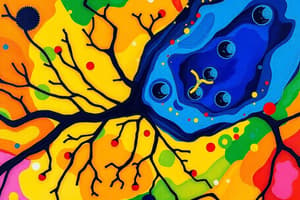Podcast
Questions and Answers
What is the primary role of ATP synthase in chloroplasts?
What is the primary role of ATP synthase in chloroplasts?
- Formation of thylakoid vesicles
- Facilitating the movement of protons down their concentration gradient (correct)
- Creation of the thylakoid membrane
- Maintenance of the intermembrane space
In the chloroplast, where does the proton gradient primarily exist?
In the chloroplast, where does the proton gradient primarily exist?
- Thylakoid space (correct)
- Intermembrane space
- Stroma
- Thylakoid membrane
What is the function of the thylakoid space within the chloroplast?
What is the function of the thylakoid space within the chloroplast?
- Production of glucose through photosynthesis
- Transduction of light energy into ATP formation (correct)
- Storage of DNA, RNA, and ribosomes
- Impermeable barrier to ions and molecules
Which compartment within the chloroplast is described as being impermeable to most ions and molecules?
Which compartment within the chloroplast is described as being impermeable to most ions and molecules?
Which region in the chloroplast contains three membrane-bound aqueous compartments?
Which region in the chloroplast contains three membrane-bound aqueous compartments?
What is a distinctive feature of the thylakoid membrane's lipid composition in chloroplasts?
What is a distinctive feature of the thylakoid membrane's lipid composition in chloroplasts?
What is the main function of ATP synthase in the context of the chemiosmotic theory?
What is the main function of ATP synthase in the context of the chemiosmotic theory?
What effect does proton pumping have on the pH of the matrix compared to the cytosol?
What effect does proton pumping have on the pH of the matrix compared to the cytosol?
Which part of the mitochondria is responsible for creating an electrochemical potential during electron transport?
Which part of the mitochondria is responsible for creating an electrochemical potential during electron transport?
What is the result of H+ ejection from the matrix during respiration, according to the chemiosmotic theory?
What is the result of H+ ejection from the matrix during respiration, according to the chemiosmotic theory?
How does electron transport through complexes I, III, and IV contribute to ATP synthesis?
How does electron transport through complexes I, III, and IV contribute to ATP synthesis?
Which component plays a direct role in attracting protons back into the matrix from the cytoplasm?
Which component plays a direct role in attracting protons back into the matrix from the cytoplasm?
Which of the following is the primary function of the inner mitochondrial membrane?
Which of the following is the primary function of the inner mitochondrial membrane?
What is the primary driving force behind ATP synthesis in mitochondria?
What is the primary driving force behind ATP synthesis in mitochondria?
Which of the following statements about the intermembrane space is correct?
Which of the following statements about the intermembrane space is correct?
What is the role of the outer mitochondrial membrane?
What is the role of the outer mitochondrial membrane?
Which of the following enzymes involved in the TCA cycle is located in the inner mitochondrial membrane?
Which of the following enzymes involved in the TCA cycle is located in the inner mitochondrial membrane?
What is the primary function of ATP synthase in mitochondria?
What is the primary function of ATP synthase in mitochondria?
Flashcards are hidden until you start studying
Study Notes
Chloroplast Structure and Function
- Chloroplasts have a diverse range of structures, from spiral chloroplasts in Spirogyra to ellipsoidal plastids in higher plant cells.
- Chloroplasts have an inner membrane system, thylakoid membrane, and an organization of paired folds (lamellae) that give rise to flattened sacs or disks (thylakoid vesicles) in stacks called grana.
- A single stack (granum) may contain dozens of thylakoid vesicles, and different grana are joined by lamellae that run through the stroma.
- Chloroplasts possess three membrane-bound aqueous compartments: intermembrane space, stroma, and thylakoid space (or lumen).
- The thylakoid space serves an important function in the transduction of light energy into ATP formation.
- The thylakoid membrane has a highly characteristic lipid composition and is impermeable to most ions and molecules.
Chloroplast Autonomy
- Chloroplasts possess DNA, RNA, and ribosomes, giving them a considerable amount of autonomy.
Mitochondrial Structure and Function
- Mitochondria are surrounded by a simple outer membrane and a more complex inner membrane.
- The space between the inner and outer membranes is the intermembrane space, where enzymes that utilize ATP (such as creatine kinase and adenylate kinase) are found.
- The outer membrane functions mainly to maintain the shape of the mitochondrion.
- The inner membrane is richly packed with proteins, lacks cholesterol, and is impermeable to molecules and ions.
- Specific transport proteins in the inner membrane carry ions, substrates, and fatty acids for oxidation across the membrane.
Chemiosmotic Theory and ATP Synthesis
- Proton pumping creates a pH gradient and an electrical gradient across the inner mitochondrial membrane.
- The proton and electrochemical gradients drive the synthesis of ATP through the flow of protons down the electrochemical gradient.
Mitochondrial Components
- The inner membrane is extensively folded, providing a large surface area in a small volume, and appears to shrink during active respiration.
- The space inside the inner mitochondrial membrane is the matrix, which contains most of the enzymes of the TCA cycle and fatty acid oxidation.
- Succinate dehydrogenase, an exception, is located in the inner membrane itself.
Studying That Suits You
Use AI to generate personalized quizzes and flashcards to suit your learning preferences.




